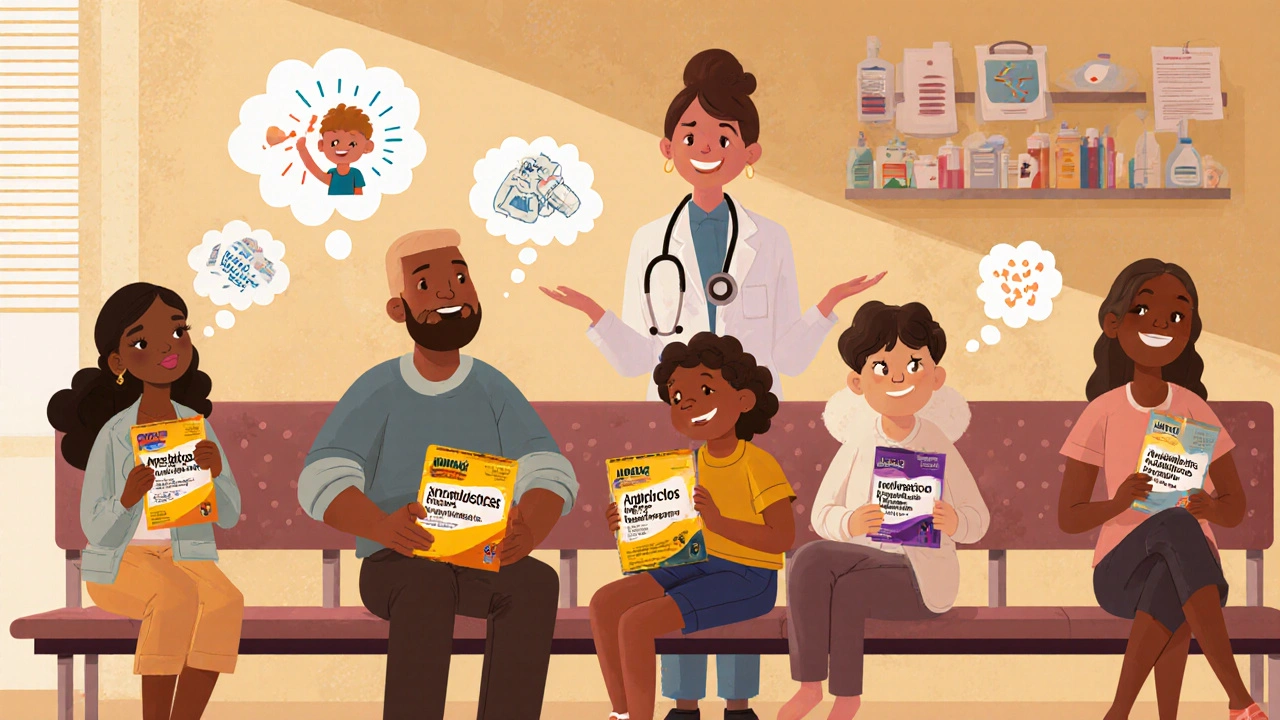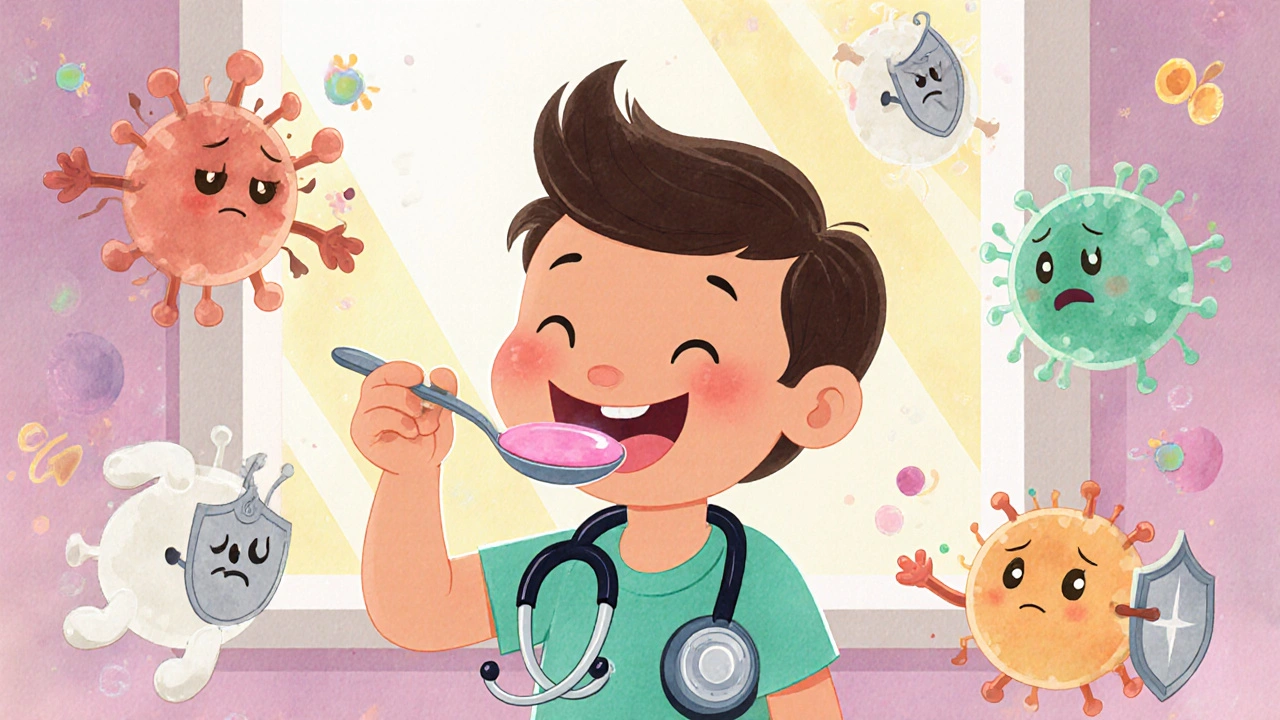Antibiotic Decision Guide
This tool helps you understand which antibiotic might be best for your specific infection based on key factors like your symptoms, allergies, and budget. Remember: always consult your doctor before changing antibiotics.
Input Your Situation
Your Antibiotic Recommendation
Comparison for Your Situation
| Antibiotic | Best For | Dosing | Key Considerations |
|---|
When you’re prescribed cefixime, you might wonder: cefixime is the one on your prescription, but is it really the best choice? Maybe you’ve heard of amoxicillin from a friend, or your doctor mentioned azithromycin as an option. You’re not alone. Many people ask if there’s a better, cheaper, or safer alternative to cefixime - especially when side effects kick in or the infection doesn’t clear up fast enough.
What Is Cefixime, Really?
Cefixime is an oral antibiotic in the cephalosporin family, specifically a third-generation one. It’s used to treat bacterial infections like strep throat, ear infections, urinary tract infections, and some types of bronchitis. It works by stopping bacteria from building their cell walls, which kills them or stops them from multiplying.
It’s not a first-line drug for every infection. In South Africa, where access to healthcare varies, cefixime is often chosen because it’s taken once a day - a big plus for people who can’t easily visit clinics or remember multiple doses. But it’s not magic. It doesn’t work against viruses, and some bacteria have grown resistant to it over time.
Why Look for Alternatives?
There are four main reasons people switch from cefixime:
- It didn’t help - the infection came back or didn’t improve after 3-4 days
- You had side effects like diarrhea, nausea, or stomach cramps
- It’s too expensive or out of stock at your pharmacy
- Your doctor suspects the bug might be resistant to it
Studies from the WHO and local health labs in Durban show rising resistance to cefixime in common strains like E. coli and Klebsiella, especially in people who’ve taken antibiotics often. That’s why alternatives matter.
Amoxicillin: The Classic Go-To
Amoxicillin is a penicillin-type antibiotic, one of the most widely used in the world. It’s cheaper than cefixime, often available as a liquid for kids, and effective for ear infections, sinusitis, and mild pneumonia.
But here’s the catch: if you’ve had a penicillin allergy - even a mild rash - you can’t take amoxicillin. Also, many bacteria now produce enzymes (beta-lactamases) that break down amoxicillin before it can work. That’s why doctors sometimes pair it with clavulanic acid (amoxicillin-clavulanate) to boost its power.
Compared to cefixime, amoxicillin works faster for some infections but needs to be taken 2-3 times a day. If you struggle with sticking to a schedule, that’s a downside.
Azithromycin: The One-Dose Wonder
Azithromycin is a macrolide antibiotic, famous for its "Z-Pak" - a 5-day course where you take a big dose on day one, then smaller ones for four more days. Some clinics even give a single 1-gram dose for certain infections like chlamydia.
It’s great for people who hate taking pills daily. It also works well against some bugs that cefixime doesn’t touch, like Mycoplasma (a common cause of walking pneumonia) and certain respiratory infections in kids.
But azithromycin has its own risks. It can cause heart rhythm changes in people with existing heart conditions. It’s also not as strong against urinary tract infections. And like cefixime, resistance is growing, especially in gonorrhea strains.

Cefdinir: The Close Cousin
Cefdinir is another third-generation cephalosporin - so it’s basically cefixime’s sibling. Both are taken once daily and work similarly against many of the same bacteria. But cefdinir is slightly more effective against certain strains of Staphylococcus and Streptococcus.
It’s also more stable in the gut, meaning less diarrhea - a common complaint with cefixime. If you had side effects from cefixime but still need a cephalosporin, cefdinir might be the better pick.
The downside? It’s often more expensive and not always in stock at public clinics. In KwaZulu-Natal, many community pharmacies carry cefixime but not cefdinir due to cost and demand.
Cephalexin: The Older, Cheaper Option
Cephalexin is a first-generation cephalosporin. It’s been around since the 1970s and is one of the cheapest antibiotics available. It’s great for skin infections, mild urinary tract infections, and some bone infections.
But it doesn’t work as well against Gram-negative bacteria like E. coli or Klebsiella - the kind often behind UTIs and some lung infections. That’s where cefixime shines.
If you’re dealing with a simple skin abscess or a mild bladder infection and want to save money, cephalexin is a solid, safe bet. But if your infection is deeper or more stubborn, cefixime or another alternative might be needed.
When to Stick With Cefixime
Cefixime still has its place. It’s the go-to for:
- Patients with penicillin allergies (unlike amoxicillin)
- Urinary tract infections caused by resistant E. coli strains
- Children who can’t swallow pills - it comes in a tasty suspension
- Situations where once-daily dosing improves compliance
In Durban’s public clinics, cefixime is often the default for pediatric ear infections because it’s effective, stable, and easy to give. If your child’s infection cleared up with it before, there’s no reason to switch unless something changed.

What Your Doctor Won’t Always Tell You
Antibiotic choice isn’t just about what works - it’s about what’s available, affordable, and safe for you. A 2024 study in the South African Medical Journal found that in low-income areas, patients often switch antibiotics mid-course because they run out of pills or can’t afford refills. That’s a big reason resistance spreads.
Also, many infections don’t need antibiotics at all. A sore throat? 80% are viral. A runny nose? Almost never bacterial. If your doctor didn’t test you, ask: "Is this definitely bacterial?" If not, antibiotics won’t help - and might hurt.
Quick Decision Guide
Here’s a simple way to think about it:
| Antibiotic | Best For | Dosing | Side Effects | Cost (ZAR, average) | Resistance Risk |
|---|---|---|---|---|---|
| Cefixime | UTIs, ear infections, gonorrhea | Once daily | Diarrhea, stomach upset | R120-R180 | Moderate to high |
| Amoxicillin | Sinus, ear, mild pneumonia | 2-3 times daily | Rash (if allergic), diarrhea | R60-R100 | High |
| Azithromycin | Walking pneumonia, chlamydia | Once daily (5 days) or single dose | Nausea, heart rhythm risk | R150-R220 | Rising fast |
| Cefdinir | Same as cefixime, less diarrhea | Once daily | Mild stomach upset | R200-R280 | Moderate |
| Cephalexin | Skin, mild UTI | 2-4 times daily | Diarrhea, rash | R40-R80 | Low |
What to Do If Cefixime Didn’t Work
If you finished your cefixime course and still feel sick:
- Don’t take leftover pills or share antibiotics with someone else.
- Go back to your clinic or doctor. Ask for a urine or throat swab test to confirm the bug.
- Ask: "Could this be resistant? What’s the next option?"
- If you can’t afford a test, explain your symptoms clearly - many clinics can still make good guesses based on local patterns.
Don’t wait until you’re worse. Delayed treatment can turn a simple infection into something serious.
Final Thoughts
Cefixime is useful - but it’s not the only tool. The right antibiotic depends on your infection, your body, your budget, and even your pharmacy’s stock. Amoxicillin is cheaper and good for many common bugs. Azithromycin is convenient but carries heart risks. Cefdinir is gentler on the gut. Cephalexin is budget-friendly for simple cases.
There’s no universal "best" antibiotic. The best one is the one that matches your infection, your life, and your health history. Always finish the full course, even if you feel better. And never self-prescribe. Antibiotics are powerful - but they’re not harmless.
Can I switch from cefixime to amoxicillin on my own?
No. Switching antibiotics without medical advice can lead to incomplete treatment, worsening infection, or antibiotic resistance. Even if amoxicillin seems similar, it won’t work for all the same infections. Always consult a doctor before changing.
Is cefixime safe for children?
Yes, cefixime is commonly prescribed for children, especially for ear infections and strep throat. It comes in a sweet liquid form that’s easier to swallow. Dosing is based on weight, so always follow your doctor’s instructions exactly.
Does cefixime interact with birth control?
Unlike some antibiotics, cefixime doesn’t reduce the effectiveness of hormonal birth control. But if you experience vomiting or severe diarrhea while taking it, your body may not absorb the pill properly. Use backup contraception during and for 7 days after treatment if this happens.
How long does it take for cefixime to work?
Most people start feeling better within 2-3 days. But you must finish the full course - usually 7 to 10 days - even if symptoms disappear. Stopping early lets surviving bacteria become resistant.
Can I drink alcohol while taking cefixime?
Yes, cefixime doesn’t have a dangerous interaction with alcohol like some other antibiotics (e.g., metronidazole). But alcohol can worsen stomach upset or dehydration, which may make side effects worse. It’s better to avoid it while you’re sick.
What should I do if I miss a dose of cefixime?
If you miss a dose and remember within 8 hours, take it right away. If it’s been longer, skip the missed dose and take the next one at the regular time. Don’t double up - it won’t help and could increase side effects.


John Greenfield
October 28, 2025 AT 08:39Cefixime? Please. That’s just a lazy doctor’s cop-out when they don’t want to think. Amoxicillin works better for 90% of cases, and if it doesn’t, you’re either allergic or the bug’s already resistant-which means you should’ve gone straight to azithromycin. Stop overcomplicating things with third-gen cephalosporins like they’re some fancy new iPhone. We’ve had cephalexin for 50 years, and it still kills the same bugs without the price tag. Also, stop prescribing antibiotics like candy. Most sore throats are viral. You’re not a hero for prescribing cefixime-you’re part of the resistance problem.
Hollis Hamon
October 28, 2025 AT 16:25I appreciate the breakdown, especially the resistance data from Durban. It’s easy to forget that access and affordability shape treatment as much as clinical guidelines. I’ve seen patients stop antibiotics after 3 days because they couldn’t afford the refill-then come back sicker. This isn’t just about microbiology; it’s about systemic inequality. Maybe we need community-based stewardship programs, not just more prescriptions.
Adam Walter
October 30, 2025 AT 05:17Let’s be crystal-clear: cefixime is the Swiss Army knife of oral cephalosporins-versatile, reliable, and surprisingly durable in the face of beta-lactamase-producing pathogens. But-and this is a *huge* but-it’s not a magic bullet. Cefdinir? Yes, gentler on the gut, but only if your pharmacy stocks it (and in rural America? Forget it). Azithromycin? Brilliant for walking pneumonia, but I’ve seen patients develop QT prolongation after a Z-pack-especially if they’re on statins or have undiagnosed arrhythmias. And cephalexin? A relic, yes-but sometimes relics are the only things left on the shelf. The real takeaway? Antibiotics are tools, not trophies. Use the right one for the job, not the one that’s easiest to write.
Gurupriya Dutta
October 30, 2025 AT 19:12My sister took cefixime for a UTI last year and had terrible diarrhea. We switched to cephalexin after the doctor said it was safe, and it worked fine. But I didn’t know cefdinir was an option-thank you for mentioning it. I wish more doctors explained alternatives like this. In India, we often get whatever’s cheapest, even if it’s not ideal. I hope this helps others ask better questions.
Michael Lynch
November 1, 2025 AT 03:22It’s wild how much this comes down to context. One person’s miracle drug is another’s nightmare. I’ve had cefixime for a sinus infection-it worked. My cousin took it for the same thing and ended up in the ER with C. diff. No one’s wrong for wanting something cheaper, easier, or gentler. The system just doesn’t make it easy to choose wisely.
caroline howard
November 1, 2025 AT 17:59Oh, so now we’re giving out gold stars for prescribing cefixime because it’s ‘once daily’? Wow. What a breakthrough. Meanwhile, people are dying from antibiotic resistance because someone thought convenience trumped efficacy. Bravo. Next up: prescribing ibuprofen for pneumonia because it’s ‘easier to swallow.’
Melissa Thompson
November 2, 2025 AT 12:44Let me be perfectly clear: The U.S. has the most advanced pharmaceutical industry in the world-and yet, here we are, debating whether to use cephalexin over cefixime like we’re in a 1980s Soviet clinic? This is embarrassing. Azithromycin? Overused. Amoxicillin? Obsolete. Cefdinir? The only rational choice-if you can get it. And if you can’t? Then you’re not a patient-you’re a statistic. America needs to stop treating antibiotics like groceries. We have the science. We have the supply. Stop settling.
Rika Nokashi
November 3, 2025 AT 01:56As someone who has witnessed the collapse of public health infrastructure in both India and the U.S., I must say that the entire discussion is fundamentally flawed. You all speak as if antibiotics are a matter of personal preference, when in reality, they are a reflection of socioeconomic decay. In rural India, children are given cefixime because it is the only one available in the government pharmacy-regardless of whether it is appropriate. In the U.S., people complain about cost, but they also demand instant cures. There is no ‘best’ antibiotic-there is only the one that survives the system. And right now, the system is failing everyone. Stop treating this like a Reddit debate. This is a moral crisis.
Don Moore
November 4, 2025 AT 05:40Thank you for the comprehensive and clinically accurate overview. I would like to emphasize the importance of culture-specific resistance patterns. In regions with high rates of ESBL-producing Enterobacteriaceae, cefixime may be inappropriate even for first-line UTI treatment. Always correlate local antibiograms with prescribing decisions. Additionally, patient education on adherence remains the single most underutilized tool in antimicrobial stewardship.
Austin Levine
November 4, 2025 AT 06:57My doctor switched me from cefixime to cefdinir after I got stomach issues. It worked better. No more diarrhea. Worth the extra cost.
Matthew King
November 4, 2025 AT 09:46bro cefixime is just the antibiotic version of a generic phone-works fine, everyone uses it, but if you got the cash, cefdinir’s the upgrade. and if you’re broke? cephalexin still gets the job done. just don’t be that guy who takes leftover antibiotics from his cousin’s last cold. we all know that guy. don’t be him.